Step-by-step AEM Content Fragments Console Extension Development
The document helps you understand how to set up local environment and start developing your first UI Extension.
About application
This example application will use two extension points provided by the Adobe Experience Manager (AEM). We would like to add two buttons. The first button will be added the header menu:
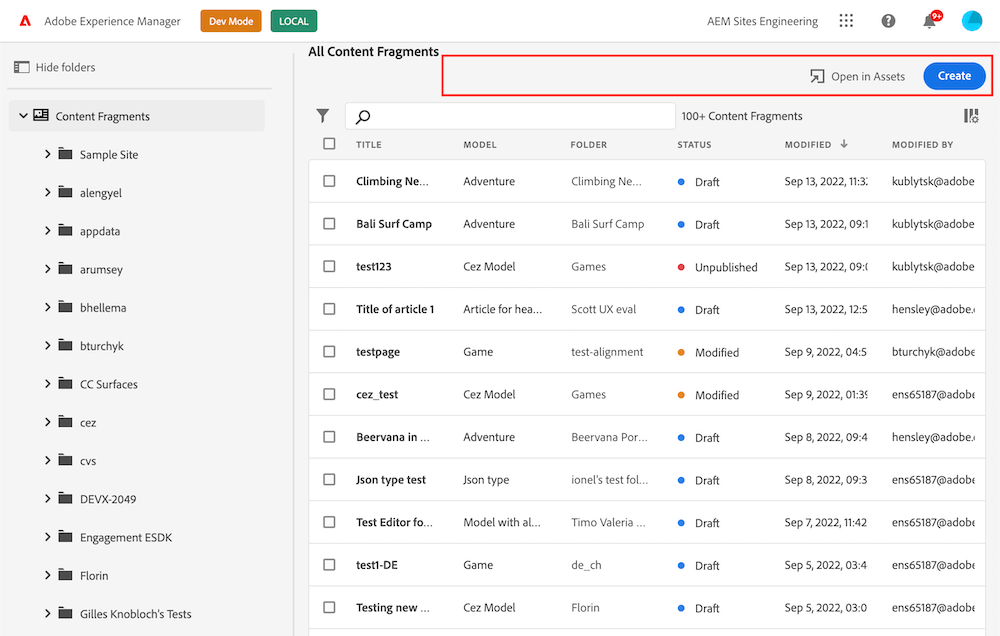
The second one to a menu that displays when a content fragment is selected:
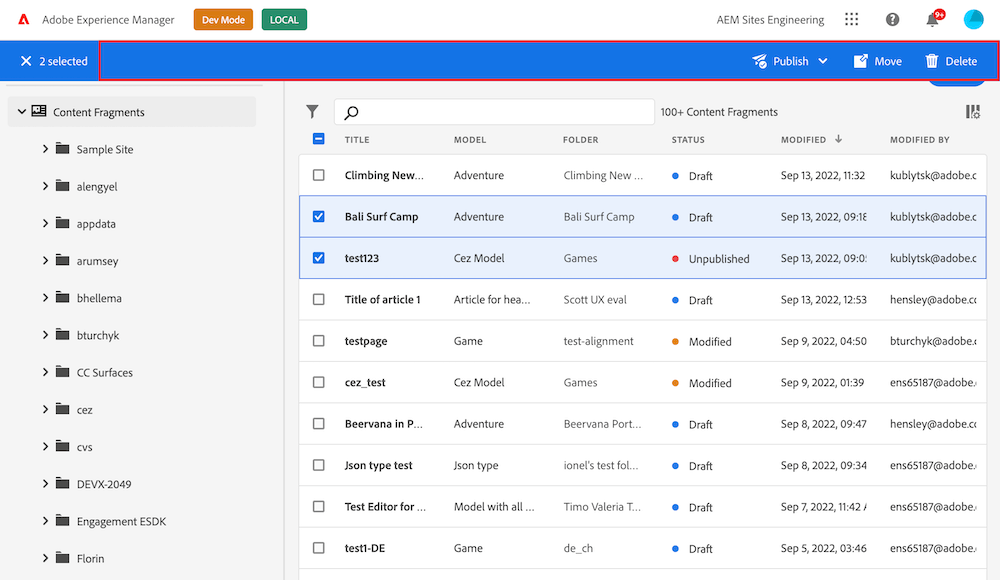
After clicking on buttons we would like to show some content in a pop-up:
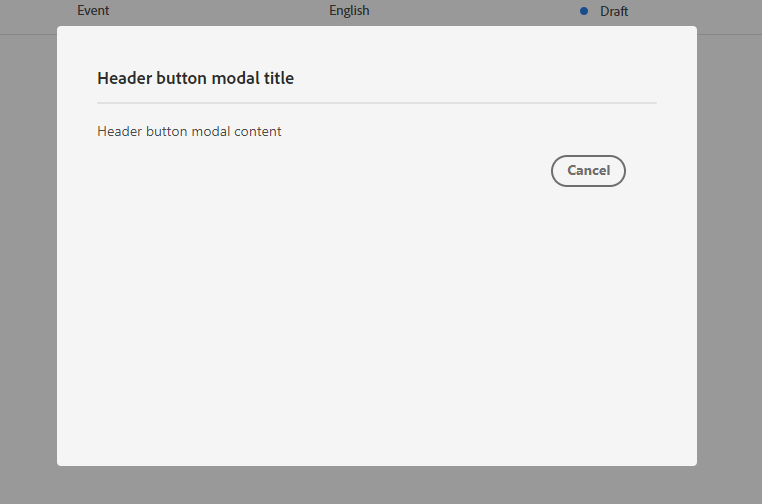
More information about AEM extension points can be found at AEM Content Fragments Console Extension Points.
Create a project in Adobe Developer Console
UI Extensions, as any App Builder application, are represented as projects in Adobe Developer Console.
If you don't have access to the Adobe Developer Console, refer to the How to Get Access guide for instructions.
To begin, we need to create a new Project which will supply us with configuration and resources.
- Sign in to Adobe Developer Console with your Adobe ID.
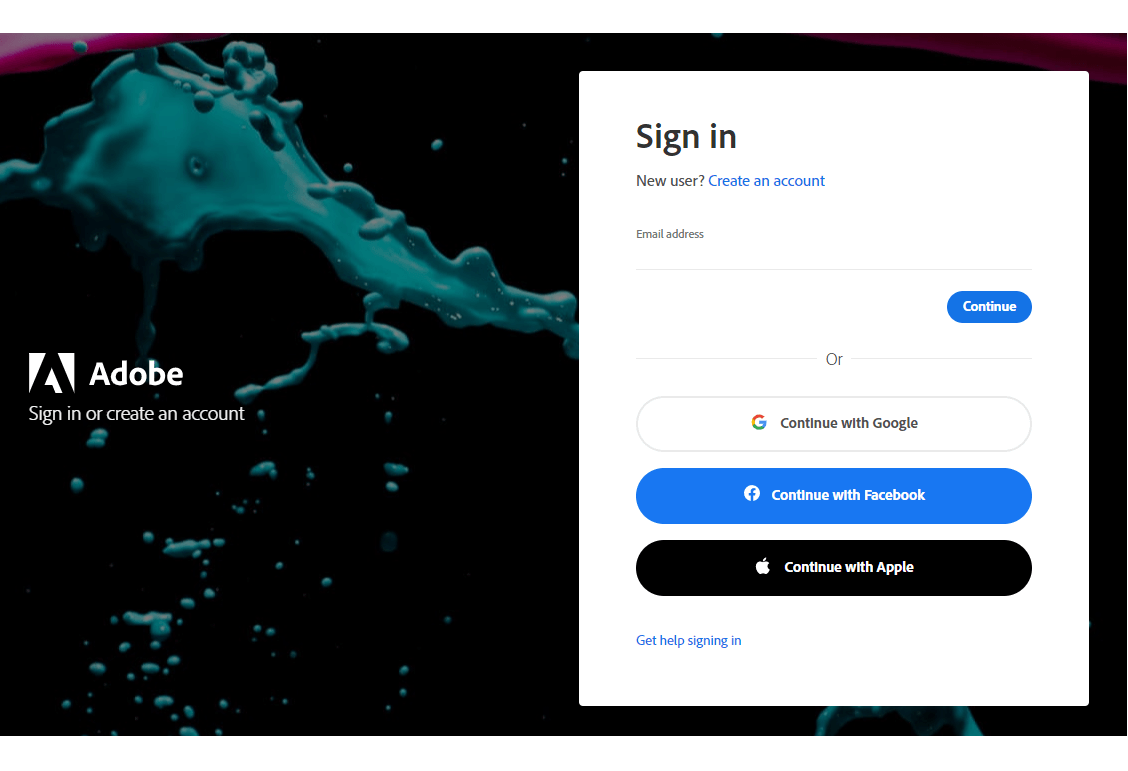
- Choose your account.
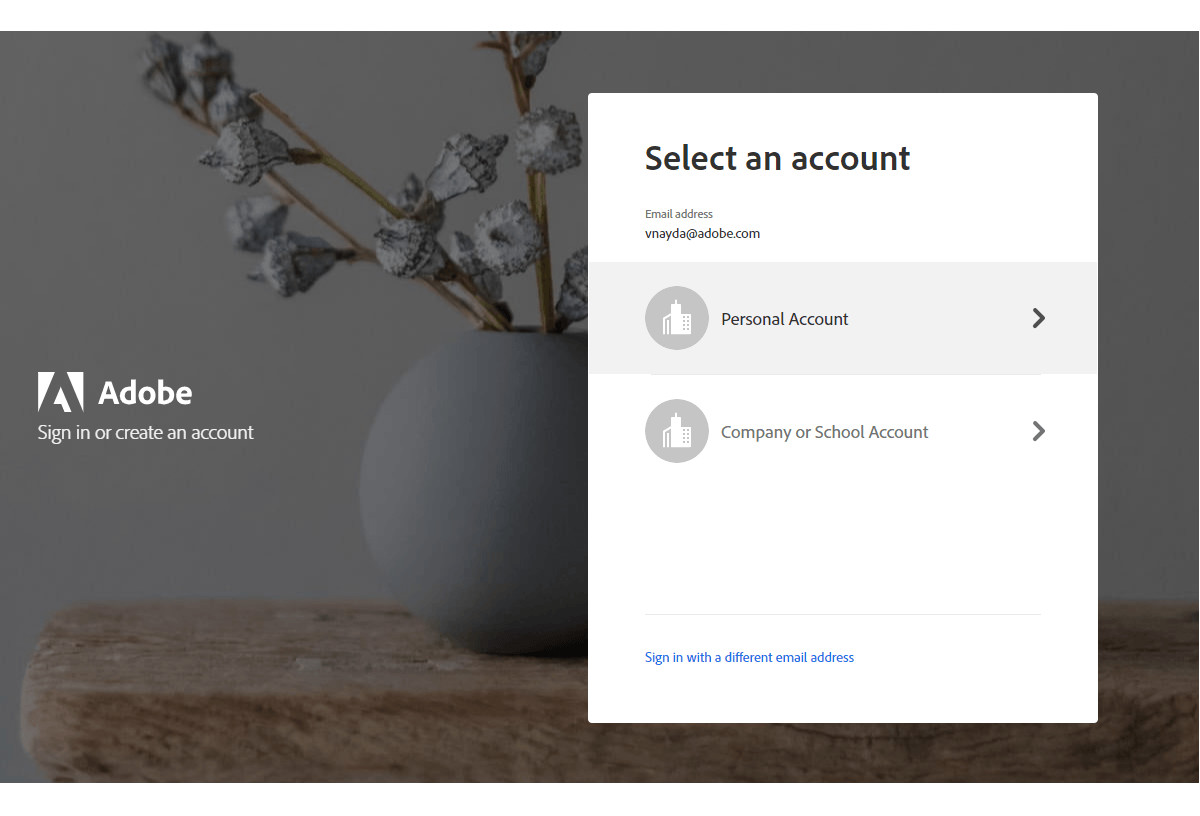
- Choose your profile or organization.

- Make sure you are in a proper organization (a switcher in the right top corner).
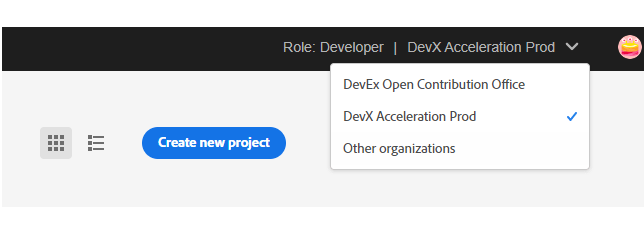
- Click "Create new project" -> "Project from template":

And choose "App Builder":
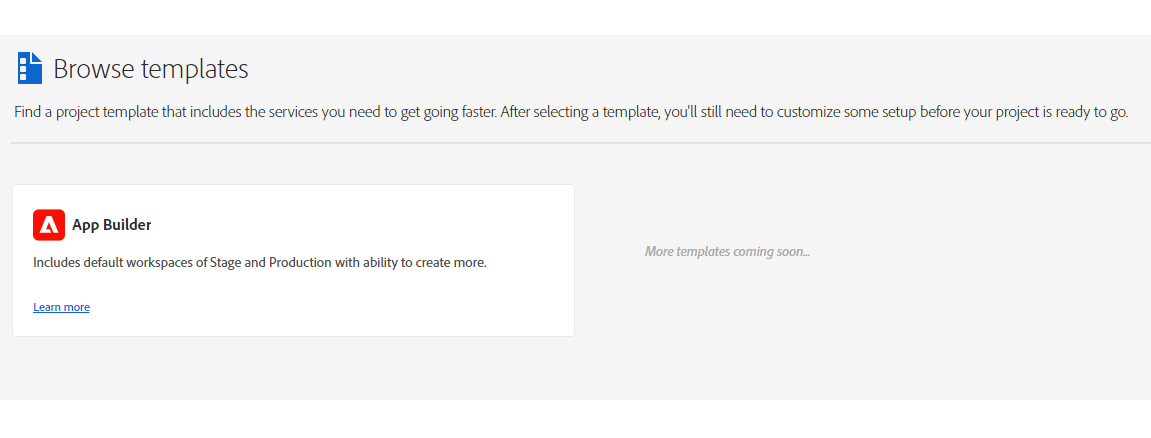
- Fill the project data.
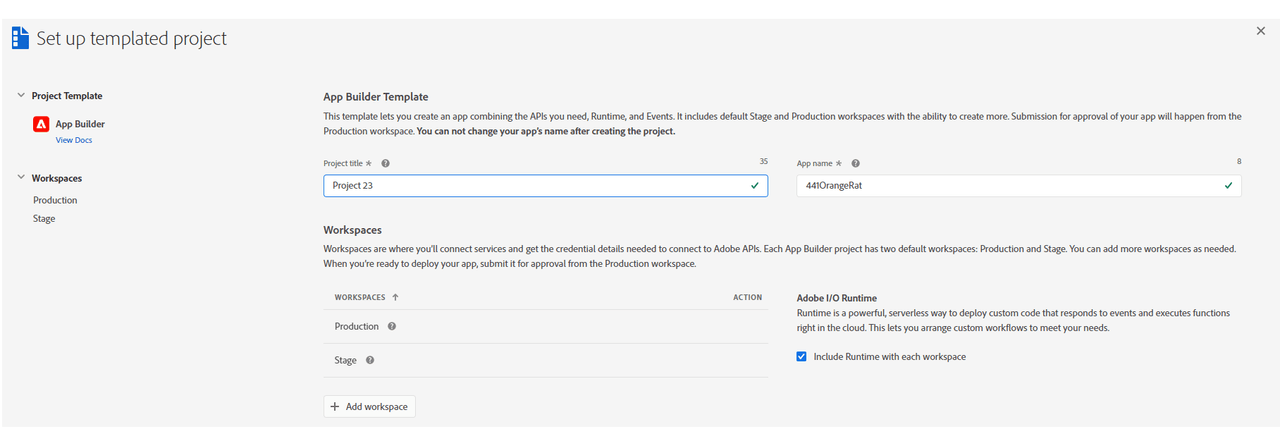
Project Titleis used to identify your project within Adobe Developer Console and in CLI.App Namewill be used as a unique identifier for your application and this value cannot be changed after project creating.
After creating, you should see a new project generated with 2 default Workspaces.
Each App Builder project has two default workspaces: Production and Stage. You can add more workspaces as needed.
The Production workspace is special, as it is used for the submission and distribution flow.
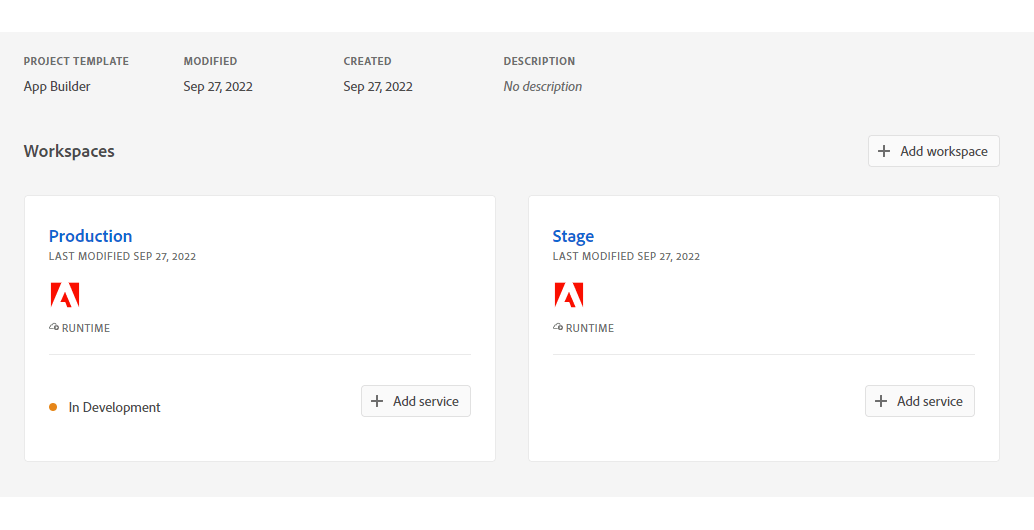
Setting up local environment
- Node.js + npm (package manager). Make sure you are using the latest stable version of
Node.jsandnpm.
Copied to your clipboard$ node -vv16.15.1
Copied to your clipboard$ npm -v8.11.0
These are the current versions at the moment of creating the documentation. Make sure you are using the latest versions supported by Adobe IO when you create the application.
If you already have Adobe I/O CLI on your local, please ensure you use the latest version of the library. You can check the version through:
Copied to your clipboardaio -v
and compare it with
Copied to your clipboardnpm show @adobe/aio-cli
If your version is outdated, update your Adobe I/O CLI by running
Copied to your clipboardnpm install -g @adobe/aio-cli
More details are described in Local environment set up.
Initialize our application using the CLI and generate a base structure from template
Firstly, we need to Signing in from CLI and bootstrap our project. Please complete all the steps described in Initialize our Application using the CLI.
After this step, we will have a generated project structure with necessary npm dependencies are getting installed.
If you have worked with an Adobe App Builder App before, you will notice that you have generated a starter project of a UI Extension that implements extension points.
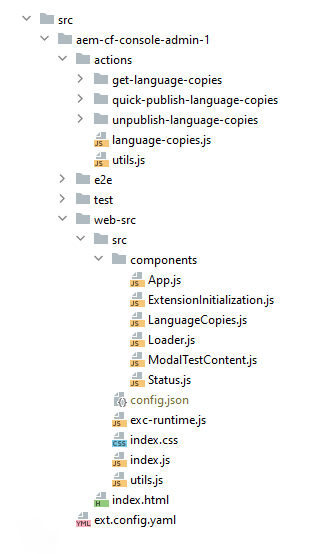
Copied to your clipboard# app.config.yamlextensions:aem-cf-console-admin-1:$include: src/aem-cf-console-admin-1/ext.config.yaml
If necessary, you can find other bootstrap options in Bootstrapping new App using the CLI.
Overview of generated components
Routing
The root component src/aem-cf-console-admin-1/web-src/src/components/App.js contains the routing of our application. We always have this generated file.
Our extension is responsible for rendering several things:
- The logic of registering our extension (it's the second required part of the extension).
- Any partial UI components that may render inside the host app, for example as the content of a pop-up when a button is clicked (optional).
We will discuss these components in more detail in the points below.
React Routing determines which part of the extension should be executed depending on the request.
Copied to your clipboardimport React from "react";import ErrorBoundary from "react-error-boundary";import LanguageCopiesModal from "./LanguageCopiesModal";import ExtensionRegistration from "./ExtensionRegistration";import TestContentModal from "./TestContentModal";import { HashRouter as Router, Routes, Route } from "react-router-dom";function App() {return (<Router><ErrorBoundary onError={onError} FallbackComponent={fallbackComponent}><Routes><Route index element={<ExtensionRegistration />} /><Routeexactpath="index.html"element={<ExtensionRegistration />}/><Routeexactpath="content-fragment/:fragmentId/language-copies"element={<LanguageCopiesModal />}/><Routeexactpath="modal-test-content"element={<TestContentModal />}/></Routes></ErrorBoundary></Router>);...}
Please note that your code may slightly differ from the given example depending on the version of the template for generation, but the main logic will be the same.
If you need additional functionality, you can add new entry points and specify them in the routing after a generation.
Extension registration
This logical component src/aem-cf-console-admin-1/web-src/src/components/ExtensionRegistration.js registers our extension with the host AEM instance as soon as it loads, so they can share data and communicate with each other.
Copied to your clipboardimport React, { useEffect } from "react";import { generatePath } from "react-router";import { Text } from "@adobe/react-spectrum";import { register } from "@adobe/uix-guest";function ExtensionRegistration() {useEffect(() => {const init = async () => {const guestConnection = await register({id: "my.company.extension-with-action-bar-button",methods: {actionBar: {getButtons() {return [{id: "my.company.manage-language-copies",label: "Manage Language Copies",icon: 'PublishCheck',onClick: (selections) => {const url = "/index.html#" + generatePath("/content-fragment/:fragmentId/language-copies", {fragmentId: encodeURIComponent(selections[0].id),});guestConnection.host.modal.showUrl({title: 'Manage Language Copy: ' + selections[0].name,url: url,})},},];},},headerMenu: {...},}});}init().catch(console.error);}, []);return <Text>IFrame for integration with Host (AEM)...</Text>;}
More details about declaration API.
We use the UIX SDK Guest library and call the register method, which connects to the host and declares methods the host can call. The getButtons() method describes the buttons which we want to add to the AEM admin panel.
In our extension we would like to add two buttons, We define the title of each button, its icon, and an onClick handler that will be run inside of the application.
In the action bar, the handler receives selected content fragments as the input parameter.
For displaying a popup, we use the <GuestUIFrame /> component provided by UIX SDK Guest library.
We indicate that we want to display the modal and specify the url at which the content should be loaded.
The declaration for the second button is very similar, but in the namespace headerMenu instead of actionBar.
This component was also generated, you can modify it if you need to change or add new logic.
Pop-up content
In the previous step, we indicated that we want to load content for the popup by URL. That content is also part of our extension application.
This component is optional and will be generated if you chose "adding UI" during project generation.
Copied to your clipboardimport { attach } from "@adobe/uix-guest";function TestContentModal() {const [guestConnection, setGuestConnection] = useState();useEffect(() => {const init = async () => {const guestConnection = await attach({ id: "aem-headless-ui-ext-examples" });setGuestConnection(guestConnection);}init().catch(console.error);}, []);return (<Provider theme={defaultTheme} colorScheme={`light`}><Content width="97%"><Text>Header button modal content</Text><ButtonGroup align="end" width="100%"><Button variant="secondary"onClick={onCancelHandler}margin="size-175">Cancel</Button></ButtonGroup></Content></Provider>);function onCancelHandler() {guestConnection.host.modal.close();}}
We again use UIX SDK Guest library, but this time we call the attach method, instead of register.
The extension is already registered; we only need to connect to the host to interact with it.
The generated content will be displayed inside the popup.
Finally, we need to mention that all of this UI uses the React and React Spectrum frameworks.
Interaction between AEM host and application
Above we said that the AEM host and the application can interact with each other. Let's look at a couple of examples.
- Work with
sharedContext. This object is designed to share data from the host to the extension. For example, the object contains theIMSdata for authentication and the hostname of the AEM instance. This means, we can make any requests to existingAEM HTTP APIto obtain additional data what we need.
Copied to your clipboardconst guestConnection = await attach({ id: "aem-headless-ui-ext-examples" });const languageCopies = await getLanguageCopies(fragmentId, guest.sharedContext.get('auth'), guest.sharedContext.get('aemHost'));
- Work with
UI modal. UI modal is the built-in part of UIX SDK Guest library. By calling the methods of this object, we can display or close the popup window.
Copied to your clipboard# during registrationconst guestConnection = await register({id: "aem-headless-ui-ext-examples",methods: {headerMenu: {getButtons() {return [{id: "my.company.export-button",// ...onClick() {guestConnection.host.modal.showUrl({title: 'Header button modal title',url: "/index.html#/modal-test-content",});},},];},},},});
Copied to your clipboard# during rendering of popup contentconst guestConnection = await attach({ id: "aem-headless-ui-ext-examples" });guestConnection.host.modal.close();
Additional information can be found in Connection Object section.
Additional logic
To add additional logic, you can modify current components or add new ones.
In our example, we have separated the UI logic and the logic of requests to the AEM instance. We have encapsulated all the requests in App Builder actions. That means that it could be reused by different views. Actions can also contain logic for making calls to any 3rd party system.
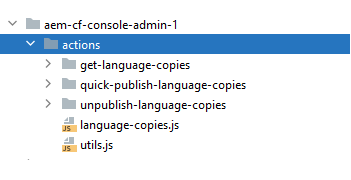
This is optional. You only need to implement it if your use case requires it.
For further information regarding the common concepts in creating extensions, you can refer to the Common Concepts in Creating Extensions.
Test on local environment
From the extension project directory, begin by running the following command:
Copied to your clipboardaio app run
This will deploy the actions to Adobe I/O Runtime, while running the UI part on the local machine.
Copied to your clipboard➜ demo-extension-project % aio app runcreate .vscode/launch.jsonNo change to package.json was detected. No package manager install will be executed.To view your local application:-> https://localhost:9080To view your deployed application in the Experience Cloud shell:-> https://experience.adobe.com/?devMode=true#/custom-apps/?localDevUrl=https://localhost:9080press CTRL+C to terminate dev environment
Now your UI extension is reachable by the displayed URL on the Terminal. You can test your UI extension within your AEM Content Fragment Console by passing the following parameters to your AEM Content Fragment Console URL:
- repo (host name of AEM instance):
repo=<CURTOMER_AEM_HOST> - ext (extension):
ext=https://localhost:9080 - devMode (development mode):
devMode=true
Sample AEM Content Fragment Console URL: https://experience.adobe.com/?devMode=true&ext=https://localhost:9080&repo=<CURTOMER_AEM_HOST>#/@<CUSTOMER_IMS_ORG>/aem/cf/admin/
Accepting the certificate (First time users)
If you are using this application for the first time, you will see a message similar to
Copied to your clipboardsuccess: generated certificateA self signed development certificate has been generated, you will need to accept it in your browser in order to use it.Waiting for the certificate to be accepted.... timed out
This message pops up because we use a development SSL certificate for secure communication. Understand more about the purpose of this certificate here.
If you see this message, please navigate to https://localhost:9080, you should see a screen similar to this.

Click on Advanced, the nex screen may vary from browser to browser, but you should see a screen like this, where you can click on Proceed to localhost (unsafe) to accept the certificate.
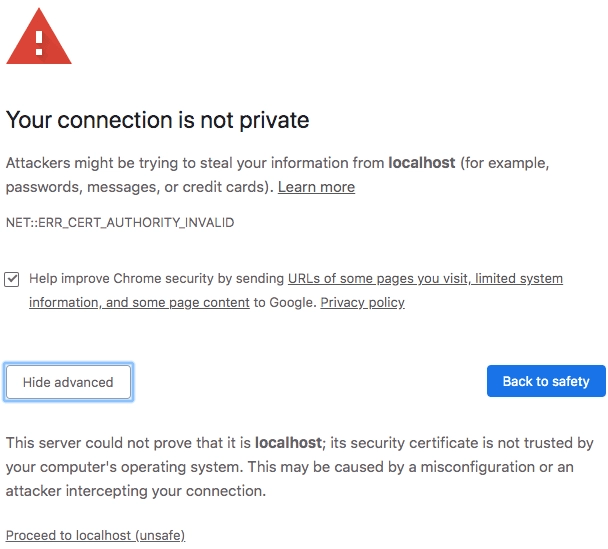
Run on Stage
After the development is completed, we can test our application on Stage before deploying to Production.
For this we will use the Stage workgroup.

Firstly, make sure you are logged in proper organization, and use Stage workgroup:
Copied to your clipboard$ aio whereYou are currently in:1. Org: Sites Internal2. Project: 562TurquoiseShrimp3. Workspace: Stage
After that, we build and deploy declared actions and frontend files/assets:
Copied to your clipboardaio app deploy√ Built 3 action(s) for 'aem-cf-console-admin-1'√ Building web assets for 'aem-cf-console-admin-1'√ Deployed 3 action(s) for 'aem-cf-console-admin-1'√ Deploying web assets for 'aem-cf-console-admin-1'Your deployed actions:web actions:-> https://245265-562turquoiseshrimp-stage.adobeio-static.net/api/v1/web/aem-headless-ui-ext-examples/get-language-copies-> https://245265-562turquoiseshrimp-stage.adobeio-static.net/api/v1/web/aem-headless-ui-ext-examples/quick-publish-language-copies-> https://245265-562turquoiseshrimp-stage.adobeio-static.net/api/v1/web/aem-headless-ui-ext-examples/unpublish-language-copiesTo view your deployed application:-> https://245265-562turquoiseshrimp-stage.adobeio-static.net/index.htmlTo view your deployed application in the Experience Cloud shell:-> https://experience.adobe.com/?devMode=true#/custom-apps/?localDevUrl=https://245265-562turquoiseshrimp-stage.adobeio-static.net/index.htmlNew Extension Point(s) in Workspace 'Stage': 'aem-cf-console-admin-1'Successful deployment 🏄
Now your application is reachable by URL, printed in Terminal. You can use this URL for end-to-end testing.
We can use the ext parameter (how we did it during testing on a local machine) of your AEM instance to test and view the unpublished application.

To learn more about deployment, please refer to Deploying the Application and Deployment Overview.
Deploy on Production and create approval request
After the application has been completed, tested locally and on Stage, we are ready to deploy it to Production.
Refer to the UI Extensions Development Flow to learn how to do this.
Also in this document you can find the whole development flow of a UI Extensions.




